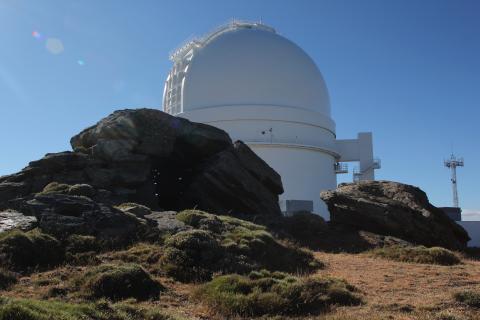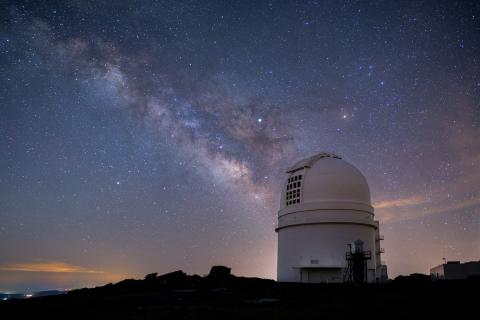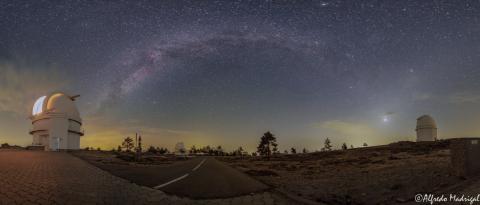



General information
-
Hosting OrganisationCentro Astronómico Hispano en Andalucía
-
AddressSierra de los Filabres sn
-
Contact Info:
-
Phone
-
Emaildirector@caha.es
Description
CAHA operates the Calar Alto Observatory. It is a partnership between the Spanish National Research Council (CSIC) and the Council of Economic Transformation, Industry, Knowledge and Universities of the Junta de Andalucía Regional Government (JA). Presently, each partner contributes with 50% of the operational costs and consequently gets 50% of the observing time. The role of the observatory is to provide world-class observing facilities to optical and near-infrared astronomers. The Calar Alto Observatory is located at an altitude of 2168 m above the sea level, in the Sierra de los Filabres (Almeria-Spain), 45 km far from the Mediterranean Sea. It is the second largest European astronomical site in the northern hemisphere, just behind the Observatorio del Roque de los Muchachos (located in the island of La Palma), and the most important in the Continental Europe, with excellent communications, making logistics easy, un-expensive and reliable
Main equipment or Facilities
Currently there are seven telescopes located in the complex, three of them belonging to Centro Astronómico Hispano en Andalucia A.I.E. (CAHA, the ICTS). The other four telescopes belong to the IAA-CSIC, Instituto Nacional de Técnica Aeroespacial (INTA, the Spanish Space Agency), the Observatorio Astronómico Nacional (OAN), and Hamburg University. Several experiments are also located at the observatory (Noctilucent clouds monitor from Leibniz Institute for Atmospheric Physics –IAP-; Camera for the observations of Transient Luminous Events -TLEs- from IAA; Weather station and monitors of seeing (RoboDIMM), extinction (CAVEX) night-sky surface brightness ASTMON), and a meteor monitoring station.
Projects under Development
Two projects are highlighted, TARSIS and MARCOT.
• TARSIS is the next generation instrument for the Calar Alto 3.5 m telescope. UCM and IAA-CSIC co-lead TARSIS, the future instrument for the Calar Alto 3.5 m telescope. TARSIS stands for Tetra-ARmed Super-Ifu Spectrograph, due to its optical design based on four arms (three optimized in blue, one in red). It is an instrument co-directed by the Complutense University of Madrid (UCM) and the IAA-CSIC, with the participation of three Andalusian universities (Almeria and Seville), the INAOE of Mexico, the industrial partner Fractal SLNE and the Astrobiology Center (CAB/INTA-CSIC) in Madrid. The combination of a wide field of view (2.8x2.8 arcminutes) and a high sensitivity from ultraviolet (in the so-called UV-A range) to red wavelengths makes TARSIS a unique instrument. The design of TARSIS and the exquisite transparency of the Calar Alto sky make possible observations in the full UV-A range, a domain almost unexplored from the ground.
• The MARCOT project is the acronym for Multi-Array of Combined Telescopes, a modular astronomical infrastructure facility for high-resolution spectroscopy and large field-of-view and high dynamic range imaging with subarcsecond spatial resolution. The main objective of the MARCOT Project is to carry out the conceptual design and establish a plan for the construction of a new European telescope concept with large effective aperture and low cost. The idea consists in the combination of multiple identical optical elements (identical mirrors or optical assemblies within manufacturing tolerances) resulting in a new infrastructure with a large effective aperture. Photons are collected by individual optical fibers connected to each optical assembly, which are finally combined by a novel multimode photonic lantern into a single fiber, which feeds a high-resolution spectrograph. In addition, each optical array is equipped with a low-noise readout detector (used for guiding and focusing), and the detector images can be subsequently combined. In this way, a single frame is generated with a signal-to-noise ratio identical to that of a large-aperture telescope, but with better resolution, dynamic range, and larger field of view.
Technology Capabilities
The observatory operates a very large array of optical and near-infrared astronomical instrumentation, including imagers and spectrographs with different fields-of-view (FOV) and resolutions. See more details at https://w3.caha.es/observing-mainmenu-148/telescopes-aamp-instruments-m… and the services provided by the ICTS can be found at https://w3.caha.es/access-and-services/brief-description
Additionally there some aspects we highlight as following:
- We foster the use of the facilities by national and international research groups that have expressed interest in the observatory's telescopes, such as the consortia of the Kepler, TESS, Gaia and Plato space missions of the European Space Agency, and the Space Situational Awareness program (focused on Near-Earth Objects) of the same Agency, which is currently using CAHA's Schmidt telescope.
- The observatory was the result of an international collaboration between the Max-Planck Society (Germany) and the CSIC. The investment in the scientific infrastructure has been appraised in 2019 at a value of approximately 150 million euros and is fully amortized in economic terms.
- The participation of the Spanish science industry in the design, manufacture and maintenance of the facilities and instruments at the observatory is very notable and helps to develop high-tech industrial capabilities that subsequently position our country's industry in a more advantageous situation in international markets.
- The multiplier effect of the science industry in innovative industrial activities of high added value is very important. Facilities such as this one provide technology companies with experience and references to present as credentials in international tenders and bids.
- Specific developments such as the spectrographs and cameras TARSIS, CARMENES, CAFÉ, PLANETCAM, PANIC, which have been, or are currently being, developed for the 2.2m and 3.5m telescopes, create a highly specialized and valuable network of Spanish companies and research centers (many of them rooted in Andalusia), in a context of full international cooperation.
Summary of Research Services
1. Observing time
2. Mirror coating services
3. Data archive
Procurement process
Procurement details can be found at https://www.caha.es/images/stories/Tenders/Instrucciones_Contratacion_C…
Call for proposals can be found at https://www.caha.es/APPS/CfP/public/